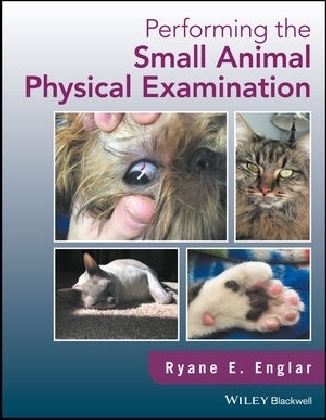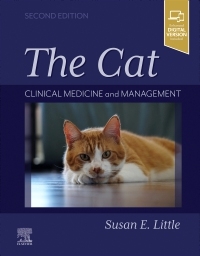
Performing the Small Animal Physical Examination
John Wiley & Sons Inc (Verlag)
978-1-119-29530-3 (ISBN)
- Bietet umfassende und praktische Informationen zur Untersuchung von Kleintieren.
- Zeigt anhand von rund 1.000 Fotos die Techniken und Prinzipien Schritt für Schritt.
- Ratschläge zur Vorbereitung des Behandlungsraums, nützliche Tipps und konkrete Leitlinien für die Untersuchung jedes Körpersystems.
- Beschreibt einen systematischen und detaillierten Ansatz für die Erstuntersuchung von Hunden und Katzen.
- Unterstützt neue und erfahrene Veterinärmediziner und Veterinärtechniker bei der Durchführung einer gründlichen Erstuntersuchung.
Ryane E. Englar, DVM, DABVP (Canine and Feline Practice), is Assistant Professor of Small Animal Primary Care at Midwestern University College of Veterinary Medicine in Glendale, Arizona, USA.
About the Author
Preface
Acknowledgments
Part One: Performing the Feline Physical Examination
1Setting the Stage: Feline-Friendly Practice
1.1 Challenges Faced in Feline Practice
1.2 The Emergency of Feline-Friendly Practice
1.3 Key Principles of Feline-Friendly Practice
1.4 The Role of Sound
1.5 The Role of Tactile Stimulation
1.6 The Role of Scent
1.7 The Role of Advance Preparation
1.8 Examination Room Etiquette: Accessing the Cat
1.9 Recognizing Body Language
1.10 Feline-Friendly Handling
1.11 Other Feline Handling Tools
2 Assessing the Big Picture: the Body, the Coat, and the Skin of the Cat
2.1 Forms of Identification
2.2 Body Condition Scoring
2.3 Assessing Hydration
2.4 Inspecting the Coat: First Impressions
2.5 Identifying Coat Colors and Coat Patterns
2.6 Assessing Coat Quality
2.7 Inspecting the Skin
3 Examining the Head of the Cat
3.1 Skull Shape and Facial Symmetry
3.2 The Eyes and Accessory Visual Structures
3.3 The Ears
3.4 The Nose
3.5 The Extra-Oral Examination
3.6 The Intra-Oral Examination
4 Examining the Endocrine and Lymphatic Systems of the Cat
4.1 Evaluating the Thyroid Gland
4.2 Assessing the Lymphatic System
5 Examining the Cardiovascular and Respiratory Systems of the Cat
5.1 The Cardiac Patient
5.2 Assessing the Cardiovascular System Prior to Auscultation
5.3 Cardiothoracic Auscultation
5.4 The Respiratory Patient
5.5 Assessing the Respiratory System Prior to Auscultation
5.6 Understanding Normal Airway Sounds
5.7 Ausculting the Airway
5.8 Understanding Adventitious Airway Sounds
5.9 Using Airway Sounds to Corroborate Percussive Findings
5.1 Purring as an Obstruction to Auscultation
6 Examining the Abdominal Cavity of the Cat
6.1 Overview of the Digestive Tract as It Pertains to Presenting Complaints
6.2 The Esophagus
6.3 Visual Inspection of the Abdomen
6.4 Superficial Palpation of the Abdomen
6.5 Deep Palpation of the Abdomen
6.6 The Upper Urinary Tract
6.7 The Lower Urinary Tract
6.8 The Male Reproductive Tract
6.9 The Female Reproductive Tract
6.1 Being Presented with a Female of Unknown Sexual Status
6.11 Neonates
7 Examining the Musculoskeletal System of the Cat
7.1 Muscle Condition Score (MCS)
7.2 The Skeleton as a Whole
7.3 The Appendicular Skeleton: The Forelimb
7.4 The Appendicular Skeleton: The Hind Limb
8 Evaluating the Nervous System of the Cat
8.1 Assessing Behavior and Mental Status
8.2 Assessing Posture
8.3 Assessing Coordination and Gait
8.4 Assessing Postural Reactions
8.5 Assessing for Other Abnormal Movements
8.6 Evaluating the Spinal Reflexes
8.7 Assessing the Cranial Nerves
8.8 Assessing Nociception
Part Two: Performing the Canine Physical Examination
9 Setting the Stage: Canine-Friendly Practice and Low-Stress Handling
9.1 Challenges Faced in Canine Practice
9.2 The Concept of Low-Stress Handling
9.3 White Coat Syndrome
9.4 The Role of Scent
9.5 The Role of Advance Preparation
9.6 Examination Room Etiquette: Setting the Tone for Initial Veterinary Interactions with the Dog
9.7 Recognizing Body Language
9.8 Creative Approaches to Challenging Interactions with Canine Patients
9.9 Other Canine Handling Tools
10 Assessing the Big Picture: the Body, the Coat, and the Skin of the Dog
10.1 Forms of Identification
10.2 Body Condition Scoring
10.3 Assessing Hydration
10.4 Breed Designation
10.5 Inspecting the Coat: First Impressions
10.6 Identifying Coat Colors and Coat Patterns
10.7 Assessing Coat Quality
10.8 Inspecting the Skin
10.9 Primary Skin Lesions
10.1 Secondary Skin Lesions
10.11 Miscellaneous Skin Lesions
10.12 Hyperkeratosis
10.13 Skin Folds
10.14 Nails and Paw Pads
10.15 Skin Incisions
10.16 Mammary Glands
11 Examining the Head of the Dog
11.1 Skull Shape: Function Versus Cosmesis
11.2 Facial Symmetry
11.3 The Eyes and Accessory Visual Structures
11.4 The Ears
11.5 The Nose
11.6 The Extra-Oral Examination
11.7 The Intra-Oral Examination
12 Examining the Endocrine and Lymphatic Systems of the Dog
12.1 Thyroid Gland Neoplasia in the Dog
12.2 The Typical Presentation of Thyroid Gland Neoplasia in the Dog
12.3 The Physiology of Hypothyroidism
12.4 The Typical Presentation of a Hypothyroid Dog
12.5 The Atypical Presentation of a Hypothyroid Dog
12.6 Assessing the Lymphatic System
12.7 Examining the Submandibular Lymph Nodes
12.8 Examining the Superficial Cervical or Pre-Scapular Lymph Nodes
12.9 Examining the Popliteal Lymph Nodes
12.1 Feeling for Lymph Nodes That Should Not Be Present
13 Examining the Cardiovascular and Respiratory Systems of the Dog
13.1 Congenital Heart Disease in the Dog
13.2 Acquired Heart Disease in the Dog
13.3 Assessing the Cardiovascular System Prior to Auscultation
13.4 Cardiothoracic Auscultation
13.5 The Respiratory Patient
13.6 Assessing the Respiratory System Prior to Auscultation
13.7 Understanding Normal Airway Sounds
13.8 Ausculting the Airway
13.9 Understanding Adventitious Airway Sounds
13.1 Panting as an Obstruction to Auscultation
14 Examining the Abdominal Cavity of the Dog
14.1 Overview of the Digestive Tract
14.2 The Esophagus
14.3 Visual Inspection of the Abdomen
14.4 Auscultation and Superficial Palpation of the Abdomen
14.5 Deep Palpation of the Abdomen
14.6 The Upper Urinary Tract
14.7 The Lower Urinary Tract
14.8 The Male Reproductive Tract
14.9 The Female Reproductive Tract
14.1 Being Presented with a Female of Unknown Sexual Status
14.11 Neonates
15 Examining the Musculoskeletal System of the Dog
15.1 Muscle Condition Score (MCS)
15.2 The Skeleton as a Whole
15.3 The Appendicular Skeleton: The Forelimb
15.4 The Appendicular Skeleton: The Hind Limb
16 Evaluating the Nervous System of the Dog
16.1 Assessing Behavior and Mental Status
16.2 Assessing Posture
16.3 Assessing Coordination and Gait
16.4 Assessing Postural Reactions
16.5 Assessing for Other Abnormal Movements
16.6 Evaluating the Spinal Reflexes
16.7 Assessing the Cranial Nerves
16.8 Assessing Nociception
Index
| Erscheinungsdatum | 16.08.2017 |
|---|---|
| Verlagsort | New York |
| Sprache | englisch |
| Maße | 218 x 283 mm |
| Gewicht | 1498 g |
| Einbandart | gebunden |
| Themenwelt | Veterinärmedizin ► Kleintier |
| Schlagworte | Kleintiere; Veterinärmedizin |
| ISBN-10 | 1-119-29530-0 / 1119295300 |
| ISBN-13 | 978-1-119-29530-3 / 9781119295303 |
| Zustand | Neuware |
| Informationen gemäß Produktsicherheitsverordnung (GPSR) | |
| Haben Sie eine Frage zum Produkt? |
aus dem Bereich


